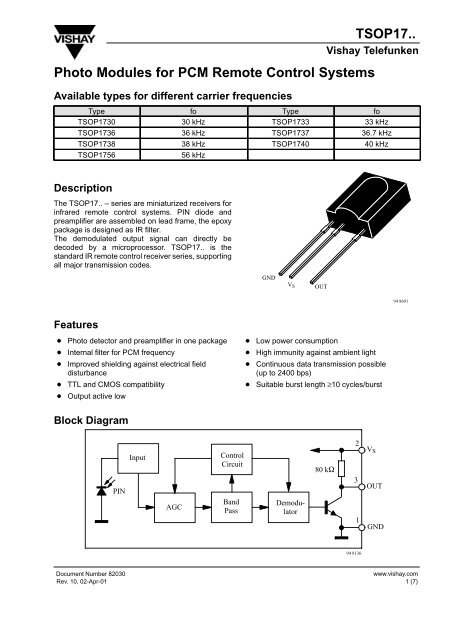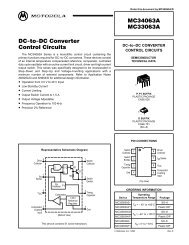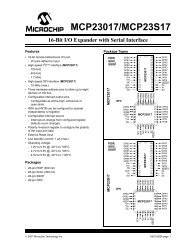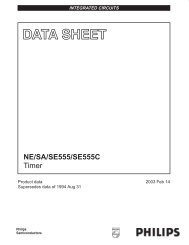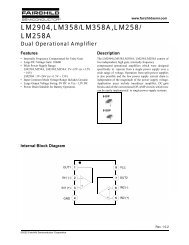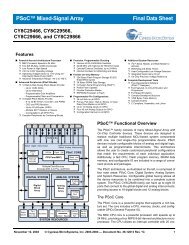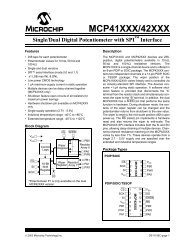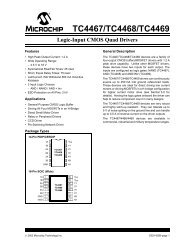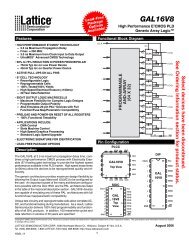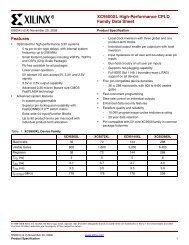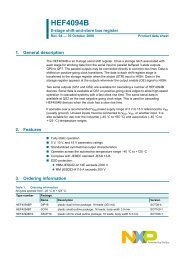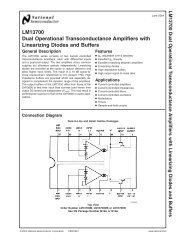TSOP1738 - Datasheet Catalog
TSOP1738 - Datasheet Catalog
TSOP1738 - Datasheet Catalog
You also want an ePaper? Increase the reach of your titles
YUMPU automatically turns print PDFs into web optimized ePapers that Google loves.
Document Number 82030<br />
Rev. 10, 02-Apr-01<br />
TSOP17..<br />
Vishay Telefunken<br />
Photo Modules for PCM Remote Control Systems<br />
Available types for different carrier frequencies<br />
Type fo Type fo<br />
TSOP1730 30 kHz TSOP1733 33 kHz<br />
TSOP1736 36 kHz TSOP1737 36.7 kHz<br />
<strong>TSOP1738</strong> 38 kHz TSOP1740 40 kHz<br />
TSOP1756 56 kHz<br />
Description<br />
The TSOP17.. – series are miniaturized receivers for<br />
infrared remote control systems. PIN diode and<br />
preamplifier are assembled on lead frame, the epoxy<br />
package is designed as IR filter.<br />
The demodulated output signal can directly be<br />
decoded by a microprocessor. TSOP17.. is the<br />
standard IR remote control receiver series, supporting<br />
all major transmission codes.<br />
Features<br />
Photo detector and preamplifier in one package<br />
Internal filter for PCM frequency<br />
Improved shielding against electrical field<br />
disturbance<br />
TTL and CMOS compatibility<br />
Output active low<br />
Block Diagram<br />
PIN<br />
Input<br />
AGC<br />
Control<br />
Circuit<br />
Band<br />
Pass<br />
GND<br />
VS OUT<br />
Low power consumption<br />
High immunity against ambient light<br />
Continuous data transmission possible<br />
(up to 2400 bps)<br />
Suitable burst length ≥10 cycles/burst<br />
Demodulator<br />
80 k<br />
2<br />
3<br />
1<br />
94 8136<br />
VS<br />
OUT<br />
GND<br />
94 8691<br />
www.vishay.com<br />
1 (7)
TSOP17..<br />
Vishay Telefunken<br />
Absolute Maximum Ratings<br />
T amb = 25C<br />
Parameter Test Conditions Symbol Value Unit<br />
Supply Voltage (Pin 2) V S –0.3...6.0 V<br />
Supply Current (Pin 2) I S 5 mA<br />
Output Voltage (Pin 3) V O –0.3...6.0 V<br />
Output Current (Pin 3) I O 5 mA<br />
Junction Temperature T j 100 C<br />
Storage Temperature Range T stg –25...+85 C<br />
Operating Temperature Range T amb –25...+85 C<br />
Power Consumption (T amb 85 C) P tot 50 mW<br />
Soldering Temperature t 10 s, 1 mm from case T sd 260 C<br />
Basic Characteristics<br />
T amb = 25C<br />
Parameter Test Conditions Symbol Min Typ Max Unit<br />
Supply y Current ( (Pin 2) ) VS = 5 V, Ev = 0 ISD 0.4 0.6 1.5 mA<br />
VS = 5 V, Ev = 40 klx, sunlight ISH 1.0 mA<br />
Supply Voltage (Pin 2) VS 4.5 5.5 V<br />
Transmission Distance Ev = 0, test signal see fig.7,<br />
IR diode TSAL6200, IF = 400 mA<br />
d 35 m<br />
Output Voltage Low (Pin 3) IOSL = 0.5 mA,Ee = 0.7 mW/m2 ,<br />
f = fo, tp/T = 0.4<br />
VOSL 250 mV<br />
Irradiance (30 – 40 kHz) Pulse width tolerance:<br />
tpi – 5/fo < tpo < tpi + 6/fo, test signal (see fig.7)<br />
Ee min 0.35 0.5 mW/m2 Irradiance (56 kHz) Pulse width tolerance:<br />
tpi – 5/fo < tpo < tpi + 6/fo, test signal (see fig.7)<br />
Ee min 0.4 0.6 mW/m2 Irradiance tpi – 5/fo < tpo < tpi + 6/fo Ee max 30 W/m2 Directivity Angle of half transmission distance ϕ1/2 ±45 deg<br />
Application Circuit<br />
TSAL62..<br />
96 12108<br />
TSOP17..<br />
2<br />
3<br />
1<br />
4.7 F *)<br />
Out<br />
100 *)<br />
>10 k<br />
optional<br />
*) recommended to suppress power supply disturbances<br />
**) The output voltage should not be hold continuously at a voltage below 3.3V by the external circuit.<br />
www.vishay.com Document Number 82030<br />
2 (7)<br />
Rev. 10, 02-Apr-01<br />
**)<br />
C<br />
+5V<br />
GND
Suitable Data Format<br />
The circuit of the TSOP17.. is designed in that way that<br />
unexpected output pulses due to noise or disturbance<br />
signals are avoided. A bandpassfilter, an integrator<br />
stage and an automatic gain control are used to<br />
suppress such disturbances.<br />
The distinguishing mark between data signal and<br />
disturbance signal are carrier frequency, burst length<br />
and duty cycle.<br />
The data signal should fullfill the following condition:<br />
• Carrier frequency should be close to center<br />
frequency of the bandpass (e.g. 38kHz).<br />
• Burst length should be 10 cycles/burst or longer.<br />
• After each burst which is between 10 cycles and 70<br />
cycles a gap time of at least 14 cycles is neccessary.<br />
• For each burst which is longer than 1.8ms a<br />
corresponding gap time is necessary at some time in<br />
the data stream. This gap time should have at least<br />
same length as the burst.<br />
• Up to 1400 short bursts per second can be received<br />
continuously.<br />
Document Number 82030<br />
Rev. 10, 02-Apr-01<br />
TSOP17..<br />
Vishay Telefunken<br />
Some examples for suitable data format are:<br />
NEC Code, Toshiba Micom Format, Sharp Code, RC5<br />
Code, RC6 Code, R–2000 Code, Sony Format<br />
(SIRCS).<br />
When a disturbance signal is applied to the TSOP17..<br />
it can still receive the data signal. However the<br />
sensitivity is reduced to that level that no unexpected<br />
pulses will occure.<br />
Some examples for such disturbance signals which<br />
are suppressed by the TSOP17.. are:<br />
• DC light (e.g. from tungsten bulb or sunlight)<br />
• Continuous signal at 38kHz or at any other<br />
frequency<br />
• Signals from fluorescent lamps with electronic<br />
ballast (an example of the signal modulation is in the<br />
figure below).<br />
0 5 10<br />
time [ms]<br />
15 20<br />
IR Signal from Fluorescent Lamp with low Modulation<br />
www.vishay.com<br />
3 (7)
TSOP17..<br />
Vishay Telefunken<br />
Typical Characteristics (T amb = 25C unless otherwise specified)<br />
e E min / e E – Rel. Responsitivity<br />
94 8143<br />
t po – Output Pulse Length (ms)<br />
1.0<br />
0.8<br />
0.6<br />
0.4<br />
0.2<br />
f = f05%<br />
f ( 3 dB ) = f0 /10<br />
0.0<br />
0.7 0.8 0.9 1.0 1.1<br />
f/f0 – Relative Frequency<br />
1.2<br />
1.3<br />
Figure 1. Frequency Dependence of Responsivity<br />
96 12110<br />
E e min – Threshold Irradiance (mW/m 2 )<br />
96 12111<br />
1.0<br />
0.9<br />
0.8<br />
0.7<br />
0.6<br />
0.5<br />
0.4<br />
0.3<br />
0.2<br />
0.1<br />
Input burst duration<br />
= 950 nm,<br />
optical test signal, fig.7<br />
0<br />
0.1 1.0 10.0 100.0 1000.0 10000.0<br />
Ee – Irradiance ( mW/m 2 )<br />
Figure 2. Sensitivity in Dark Ambient<br />
5.0<br />
4.5<br />
4.0<br />
Correlation with ambient light sources<br />
( Disturbance effect ) : 10W/m<br />
3.5<br />
3.0<br />
2.5<br />
2.0<br />
1.5<br />
1.0<br />
0.5<br />
0<br />
0.01 0.10 1.00 10.00 100.00<br />
21.4 klx<br />
( Stand.illum.A, T = 2855 K )8.2 klx<br />
( Daylight, T = 5900 K )<br />
Ambient, = 950 nm<br />
E – DC Irradiance (W/m 2 )<br />
Figure 3. Sensitivity in Bright Ambient<br />
0.0<br />
0.0 0.4 0.8 1.2 1.6<br />
www.vishay.com Document Number 82030<br />
4 (7)<br />
Rev. 10, 02-Apr-01<br />
E – Threshold Irradiance ( mW/m 2<br />
e min<br />
)<br />
94 8147<br />
E – Threshold Irradiance ( mW/m 2<br />
e min<br />
)<br />
2.0<br />
1.6<br />
1.2<br />
0.8<br />
0.4<br />
f(E)=f0<br />
E – Field Strength of Disturbance ( kV / m )<br />
Figure 4. Sensitivity vs. Electric Field Disturbances<br />
10<br />
1<br />
f = f0<br />
10 kHz<br />
100 Hz<br />
0.1<br />
0.01 0.1 1 10 100<br />
1 kHz<br />
2.0<br />
1000<br />
94 9106 VsRMS – AC Voltage on DC Supply Voltage ( mV )<br />
Figure 5. Sensitivity vs. Supply Voltage Disturbances<br />
E e min – Threshold Irradiance (mW/m 2 )<br />
96 12112<br />
1.0<br />
0.9<br />
0.8<br />
0.7<br />
0.6<br />
0.5<br />
0.4<br />
0.3<br />
0.2<br />
0.1<br />
Sensitivity in dark ambient<br />
0<br />
–30 –15 0 15 30 45 60 75 90<br />
Tamb – Ambient Temperature ( °C )<br />
Figure 6. Sensitivity vs. Ambient Temperature
E e<br />
V O<br />
V OH<br />
V OL<br />
Ee<br />
VO<br />
VOH<br />
VOL<br />
Envelope Duty Cycle<br />
16155<br />
Optical Test Signal<br />
(IR diode TSAL6200, I F = 0.4 A, 30 pulses, f = f 0, T = 10 ms)<br />
Output Signal<br />
t d 1 )<br />
Document Number 82030<br />
Rev. 10, 02-Apr-01<br />
t pi *<br />
T<br />
* tpi 10/fo is recommended for optimal function<br />
1 ) 7/f0 < t d < 15/f 0<br />
2 ) tpo = t pi 6/f 0<br />
t po 2<br />
)<br />
Figure 7. Output Function<br />
Optical Test Signal<br />
0.9<br />
0.8<br />
0.7<br />
0.6<br />
0.5<br />
0.4<br />
0.3<br />
0.2<br />
0.1<br />
600 s 600 s<br />
Ton<br />
T = 60 ms<br />
Output Signal, ( see Fig.10 )<br />
Toff<br />
Figure 8. Output Function<br />
0<br />
10 20 30 40 50 60 70 80 90<br />
Burstlength [number of cycles/burst]<br />
t<br />
t<br />
16110<br />
t<br />
t<br />
94 8134<br />
Figure 9. Max. Envelope Duty Cycle vs. Burstlength<br />
T on ,T off – Output Pulse Length (ms)<br />
96 12114<br />
I s – Supply Current ( mA )<br />
96 12115<br />
1.0<br />
0.9<br />
0.8<br />
0.7<br />
0.6<br />
0.5<br />
0.4<br />
0.3<br />
0.2<br />
0.1<br />
TSOP17..<br />
Vishay Telefunken<br />
Toff<br />
Ton<br />
= 950 nm,<br />
optical test signal, fig.8<br />
0<br />
0.1 1.0 10.0 100.0 1000.0 10000.0<br />
Ee – Irradiance (mW/m 2 )<br />
Figure 10. Output Pulse Diagram<br />
1.0<br />
0.9<br />
0.8<br />
0.7<br />
0.6<br />
0.5<br />
0.4<br />
0.3<br />
0.2<br />
0.1<br />
0<br />
Vs = 5 V<br />
–30 –15 0 15 30 45 60 75 90<br />
Tamb – Ambient Temperature ( °C )<br />
Figure 11. Supply Current vs. Ambient Temperature<br />
S ( ) rel – Relative Spectral Sensitivity<br />
94 8408<br />
1.2<br />
1.0<br />
0.8<br />
0.6<br />
0.4<br />
0.2<br />
0<br />
750 850 950 1050<br />
– Wavelength ( nm )<br />
1150<br />
Figure 12. Relative Spectral Sensitivity vs. Wavelength<br />
www.vishay.com<br />
5 (7)
TSOP17..<br />
Vishay Telefunken<br />
1.0<br />
0.9<br />
0.8<br />
0.7<br />
95 11339p2<br />
0.6<br />
0°<br />
10° 20°<br />
0.4 0.2 0 0.2 0.4 0.6<br />
drel – Relative Transmission Distance<br />
Figure 13. Vertical Directivity ϕ y<br />
Dimensions in mm<br />
30°<br />
40°<br />
50°<br />
60°<br />
70°<br />
80°<br />
95 11340p2<br />
0.4 0.2 0 0.2 0.4 0.6<br />
www.vishay.com Document Number 82030<br />
6 (7)<br />
Rev. 10, 02-Apr-01<br />
1.0<br />
0.9<br />
0.8<br />
0.7<br />
0.6<br />
0°<br />
10° 20°<br />
drel – Relative Transmission Distance<br />
Figure 14. Horizontal Directivity ϕ x<br />
96 12116<br />
30°<br />
40°<br />
50°<br />
60°<br />
70°<br />
80°
Ozone Depleting Substances Policy Statement<br />
It is the policy of Vishay Semiconductor GmbH to<br />
1. Meet all present and future national and international statutory requirements.<br />
Document Number 82030<br />
Rev. 10, 02-Apr-01<br />
TSOP17..<br />
Vishay Telefunken<br />
2. Regularly and continuously improve the performance of our products, processes, distribution and operating<br />
systems with respect to their impact on the health and safety of our employees and the public, as well as their<br />
impact on the environment.<br />
It is particular concern to control or eliminate releases of those substances into the atmosphere which are known as<br />
ozone depleting substances (ODSs).<br />
The Montreal Protocol (1987) and its London Amendments (1990) intend to severely restrict the use of ODSs and<br />
forbid their use within the next ten years. Various national and international initiatives are pressing for an earlier ban<br />
on these substances.<br />
Vishay Semiconductor GmbH has been able to use its policy of continuous improvements to eliminate the use of<br />
ODSs listed in the following documents.<br />
1. Annex A, B and list of transitional substances of the Montreal Protocol and the London Amendments respectively<br />
2. Class I and II ozone depleting substances in the Clean Air Act Amendments of 1990 by the Environmental<br />
Protection Agency (EPA) in the USA<br />
3. Council Decision 88/540/EEC and 91/690/EEC Annex A, B and C (transitional substances) respectively.<br />
Vishay Semiconductor GmbH can certify that our semiconductors are not manufactured with ozone depleting<br />
substances and do not contain such substances.<br />
We reserve the right to make changes to improve technical design and may do so without further notice.<br />
Parameters can vary in different applications. All operating parameters must be validated for each customer application<br />
by the customer. Should the buyer use Vishay-Telefunken products for any unintended or unauthorized application, the<br />
buyer shall indemnify Vishay-Telefunken against all claims, costs, damages, and expenses, arising out of, directly or<br />
indirectly, any claim of personal damage, injury or death associated with such unintended or unauthorized use.<br />
Vishay Semiconductor GmbH, P.O.B. 3535, D-74025 Heilbronn, Germany<br />
Telephone: 49 (0)7131 67 2831, Fax number: 49 (0)7131 67 2423<br />
www.vishay.com<br />
7 (7)
This datasheet has been downloaded from:<br />
www.<strong>Datasheet</strong><strong>Catalog</strong>.com<br />
<strong>Datasheet</strong>s for electronic components.


